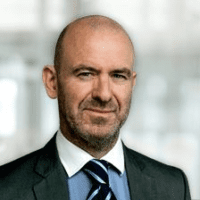

It’s a warm, sunny afternoon when The Interview sits down with Martin Inganaes, but if he’s feeling any heat, it’s not showing. He’s measured, collected and very much on the ball.
That’s a good thing because, as Hilti’s global head of ON!Track, he’s at the heart of everything the OEM does in its self-avowed mission to be a positive force for good in construction. And, as the conversation unfolds, we get a clear idea not only of what motivates Inganaes, but also a strong understanding of what drives Hilti.
“Hilti’s mission is making construction better,” says Inganaes. “If you really want to live up to that promise, you need to work on the things that are truly relevant for customers. And when it comes to productivity, we believe that there is massive potential for construction companies to take productivity to the next level by improving processes.”
“…there is massive potential for construction companies to take productivity to the next level by improving processes.”
Construction has always been a complex, high-stakes industry, but the challenges have evolved, he says. While Hilti built its reputation on delivering high-performance tools, consumables, and equipment, Inganaes says the real productivity gains today also require focus on the less tangible domain of workflows and planning.
“Many of the key challenges that construction is facing today are actually related to business processes — how do you plan your work? How do you document your work? How do you make sure the people who need to do the job are available, and that the tools, equipment, and materials are where they need to be?” says Inganaes, who joined Hilti way back in 2011. “More and more, we see that if you really want to take productivity to the next level, you have to improve business processes.”
That focus has pushed Hilti further into software and IoT, areas where Inganaes leads innovation through ON!Track, its equipment management solution. ON!Track — part of Hilti’s ongoing strategic partnership with Trackunit — enables contractors to manage and track tools, equipment, and materials, ensuring resources are optimized and downtime is minimized.
“It is about working with today’s technologies and integrating feedback from customers, while constantly investing in the future so we can be an even better partner tomorrow,” he says.
Technology with purpose
For Hilti, technology is never about novelty for its own sake. Inganaes says that waiting for the perfect innovation is a recipe for inertia. Instead, the company deploys the best solutions available today, refines them with customer input, and builds toward even greater impact. Safety is a prime example.
“We aim to be an innovation leader, but part of that is asking ourselves how we can bring innovation faster. In many cases, that means collaborating where companies like Trackunit have competencies we don’t, or where we can build stronger know-how together.”
Inganaes can point to years of advances that have made a tangible difference on site: built-in safety mechanisms on tools to help prevent injuries, dust management systems to support protection of workers’ health, and exoskeletons to aid workers during physically demanding tasks.
“We’ve also built safety into our software,” he adds. “It’s about ensuring that tools and equipment are maintained and inspected at regular intervals, something that’s very difficult to do without a professional solution. Through software, we can also manage certifications, making sure the people using the tools have the training they need.”
The emphasis on safety has knock-on benefits for productivity and sustainability, as well-maintained tools last longer and reduce waste. It also supports construction companies’ efforts to attract and retain skilled workers by improving working conditions.

The benefits of partnerships
While Hilti has deep internal capabilities, Inganaes is clear that partnerships such as it enjoys with Trackunit are essential to achieving its vision, especially in relatively new domains like IoT and software.
“We aim to be an innovation leader, but part of that is asking ourselves how we can bring innovation faster,” he says. “In many cases, that means collaborating where companies like Trackunit have competencies we don’t, or where we can build stronger know-how together.”
One example, says Inganaes, is the integration of the Bluetooth capabilities of ON!Track with heavy equipment management telematics, creating a connected ecosystem for the benefits of our customers.
“The more players join this network, the better the solution for our joint customers,” Inganaes says. “Customers expect software to be integrated. If we really want to drive productivity, it’s about being able to bring data from one process into another — and that requires collaboration.”
“Making construction better is about helping the industry become more productive, safer, and more sustainable. That’s why it’s only logical and natural for us to focus on processes…”
This openness is part of what he describes as a “construction ecosystem philosophy,” where every player contributes to a greater good. Partnerships, in this view, are not just a pragmatic way to fill capability gaps, but a deliberate strategy to deliver better outcomes for customers and the industry.
Making technology accessible
Even as construction technology matures, Hilti recognizes that adoption varies widely across the sector. Larger contractors may have in-house tech teams, but many mid-sized firms do not.
“A lot of customers need help in understanding what the best solutions are and in adopting them,” Inganaes says. “That’s where our direct customer relationships are so important. It’s not only about developing the technology, but about helping our customers put it to use.”
This “holding hands” approach — providing not just tools, but guidance and integration support — is central to Hilti’s differentiation.
In many ways, Hilti’s mission to make construction better aligns closely with the industry-wide mission to eliminate downtime.
“Downtime is about reducing waste and making companies more productive,” Inganaes says. “With ON!Track, for example, we help customers avoid theft and loss, improve utilization, and maintain tools so they last longer. We also make sure equipment is in the right place when it’s needed. If it’s not, that’s downtime. So I think we are very much on a joint mission — we just use slightly different terminology.”
Process as conviction
For Inganaes, improving processes is more than an initiative — it’s deeply anchored in the company strategy and shapes Hilti’s culture and long-term direction. The company’s private, family-owned structure supports this, enabling long-term investments that prioritize people and planet alongside profitability.
“Making construction better is about helping the industry become more productive, safer, and more sustainable,” he says.“That’s why it’s only logical and natural for us to focus on processes — because that’s where many of the biggest gains for our customers, the industry, and the planet can be found.”
Hilti’s willingness to “trust the process” — in both the literal and philosophical sense — is paying dividends. It’s delivering practical, integrated solutions that address today’s most pressing challenges, while building the foundation for tomorrow’s innovations.
And for construction as a whole, that commitment means more than just incremental gains. It means a step-change in how the industry works, collaborates, and thrives. Ultimately, Inganaes comes across as a firm believer in the good construction can do, and an advocate for an industry that is sometimes unfairly maligned.
“What construction is doing for this planet is just amazing, right?” he says, with clear passion. “Everyone around us is being affected by by construction, be it in our own houses where we live or the schools where our kids go and the surrounding infrastructure.
“Construction is everywhere,” he adds. “It’s a very special industry and every construction project is different. It leaves a very strong mark on every one of us.”
The Interview is our forum for leading industry personalities to discuss the big issues facing construction, what the solutions could be, and what needs to be done to make it a force for progress. Read more here.


Be first to hear about product launches, updates, and industry insights